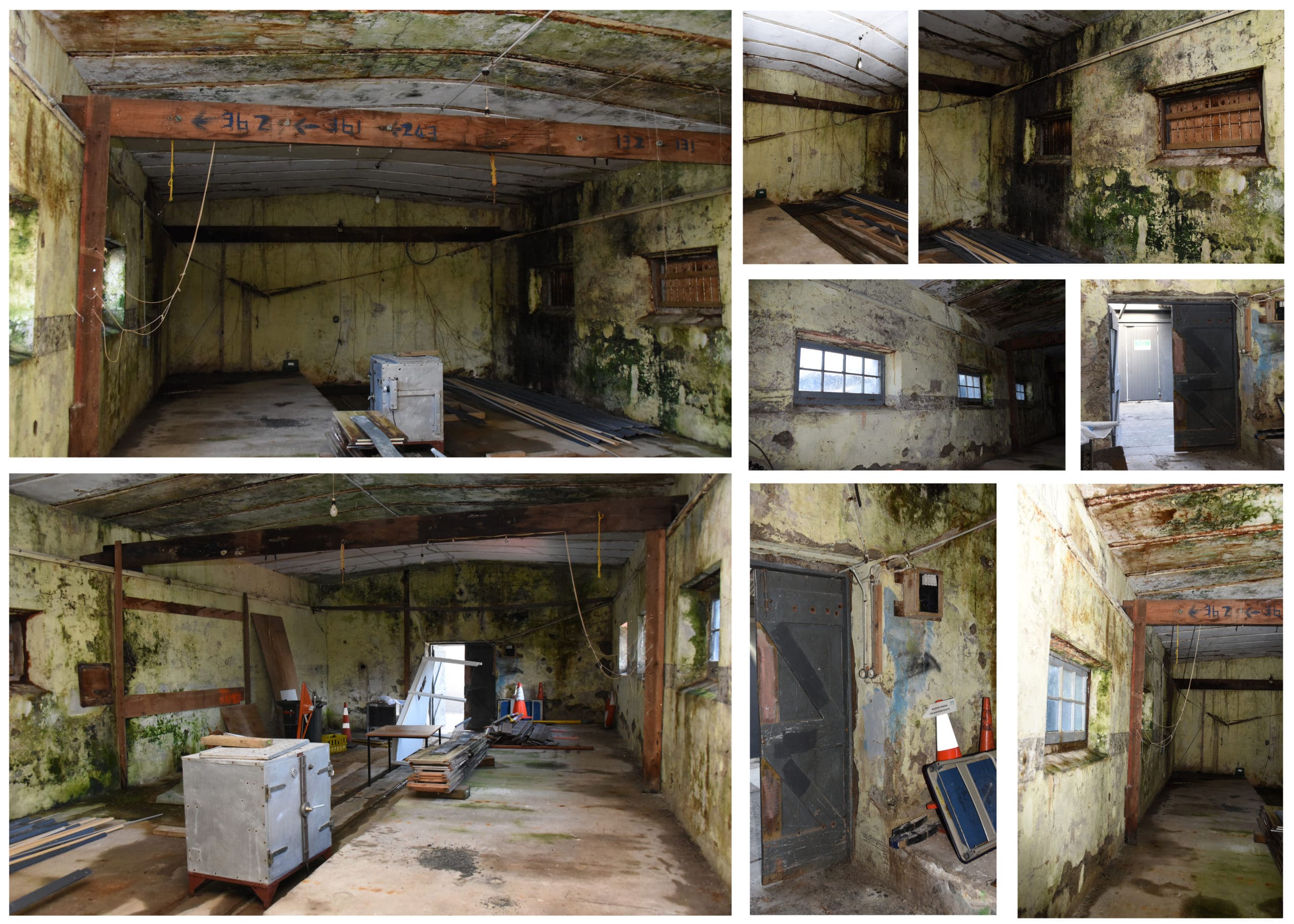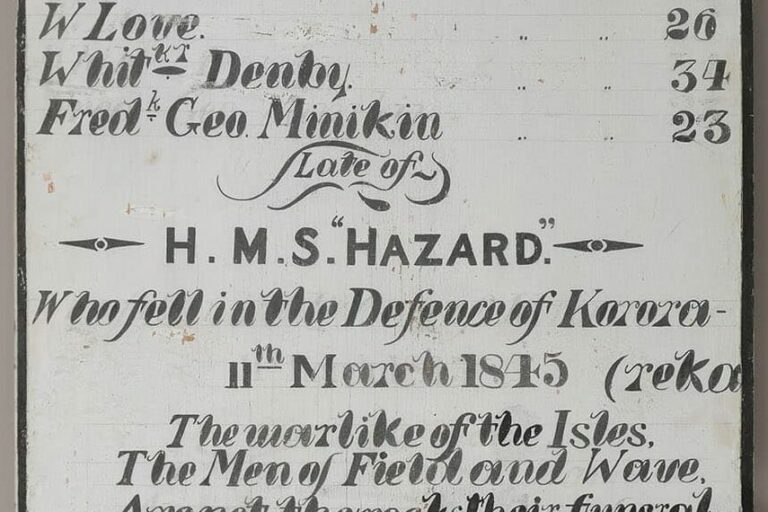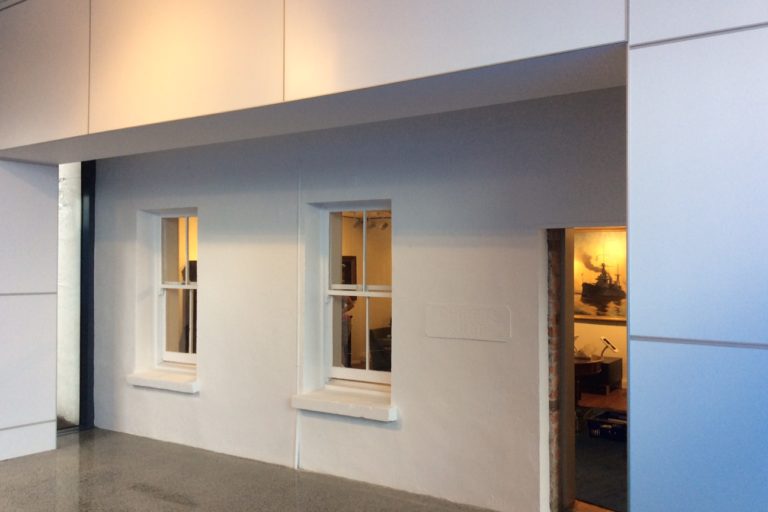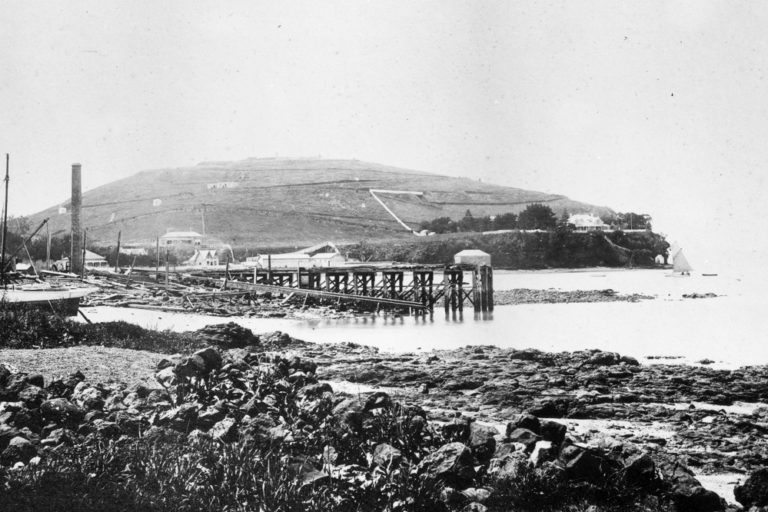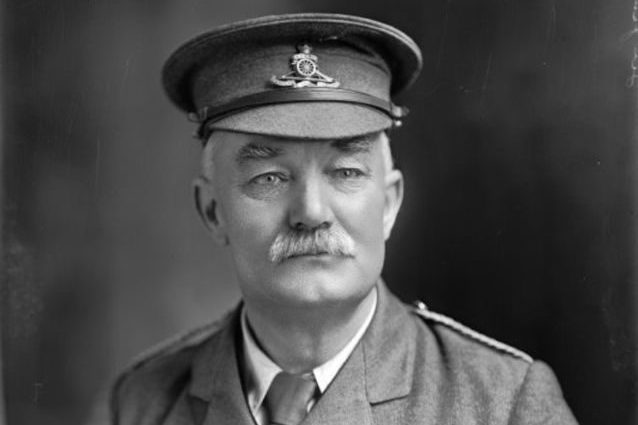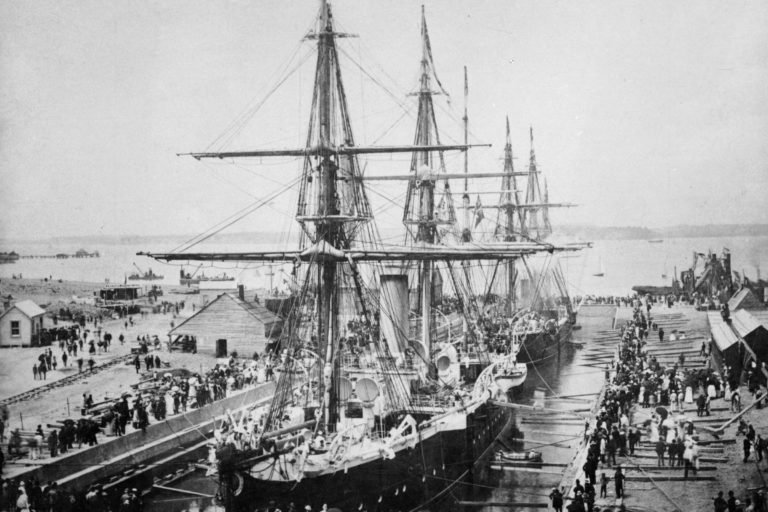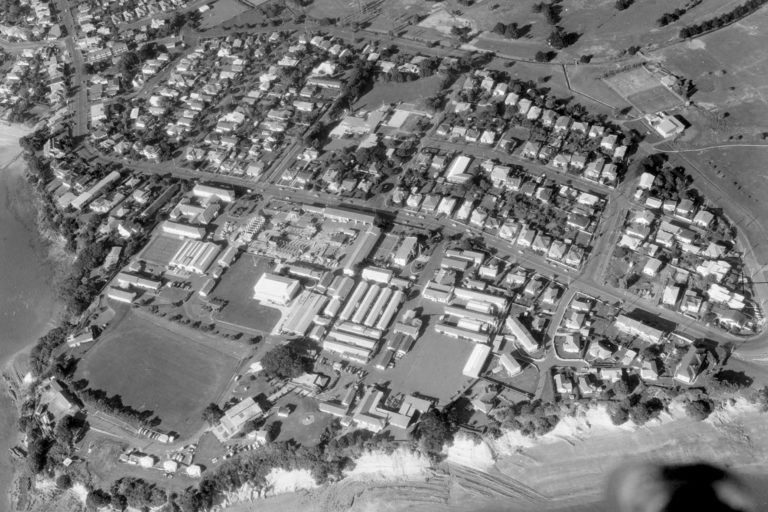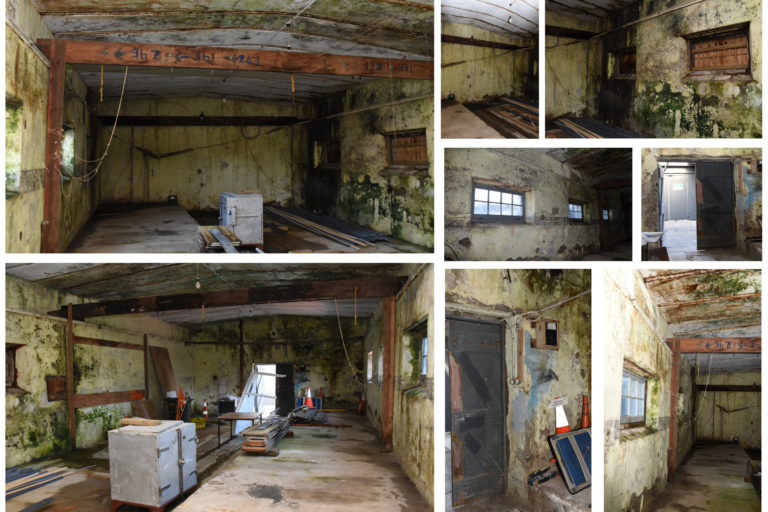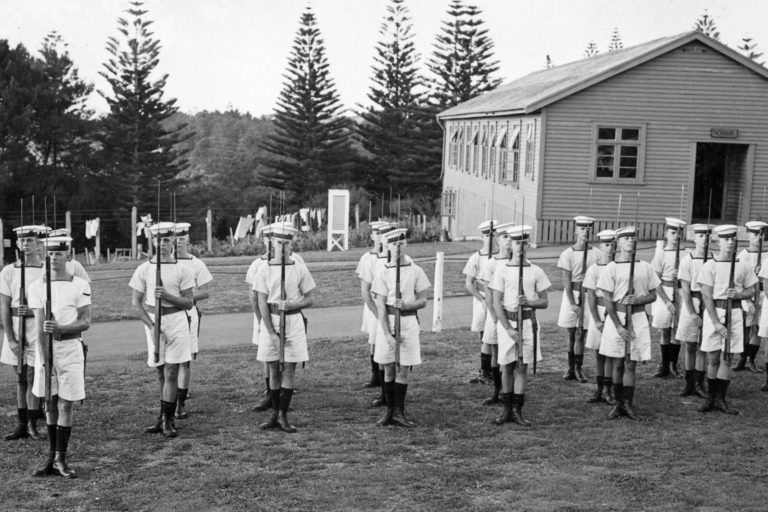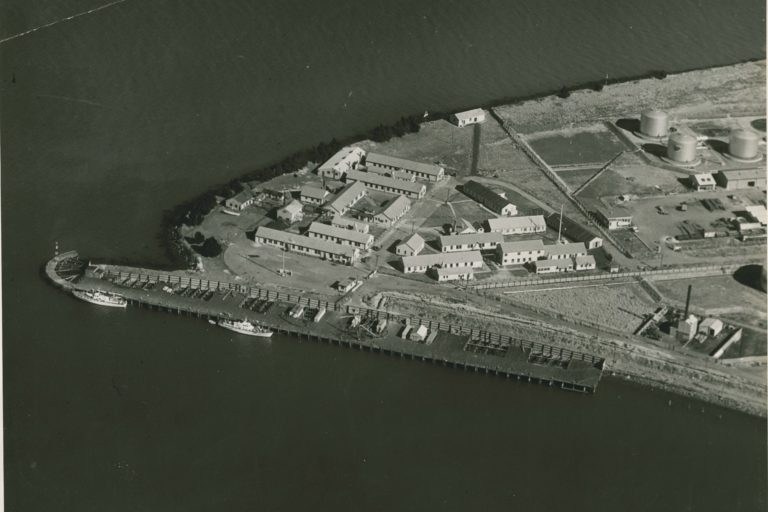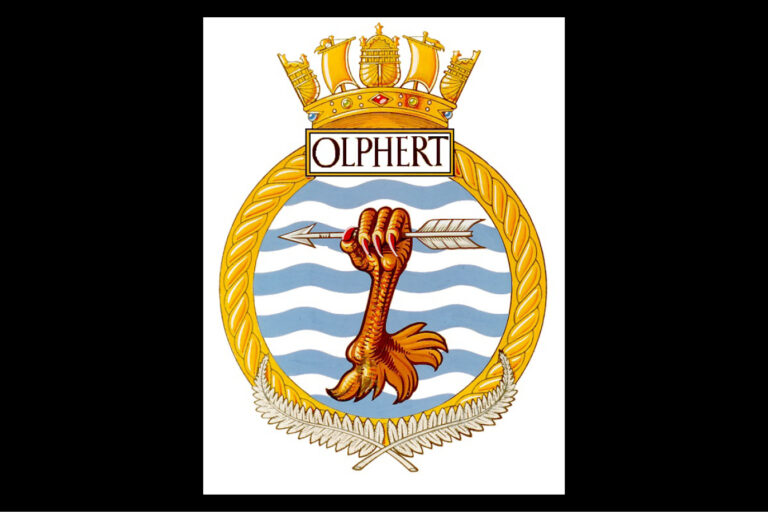Torpedo Bay boatyard has a fascinating story to tell. Many of the buildings date from the days of the mining base and it is one of the most intact examples of a nineteenth century mining establishment in New Zealand and possibly in the Southern Hemisphere. In addition, each of the individual buildings tells a part of the story and contributes to an understanding as to how the base functioned. The Minestore is currently being restored and repurposed as two new gallery spaces and a new learning space as part of the Navy Museum. Read more about the restoration project and view our Q & As.
View a timeline of the history of Torpedo Bay.
The Beginning
The year is 1858 and George Beddoes has established a shipbuilding yard at the bottom of North Head overlooking Torpedo bay or Pilot Bay as it was called at the time. Military involvement with the boatyard began in 1871 when Captain Hutton suggested that is would make a good location for a torpedo base[1] which would become part of Auckland’s defences. In 1885, the “Russian Scare” provided a good reason for finally getting the project under way.
The man responsible for its design was Colonel Tudor Boddam and, between 1885 and 1887, land was compulsorily acquired from adjoining landowners. Work to reclaim further land from the harbour bed also began at this time. A jetty[2] was constructed, along with workshops, offices and a building to store torpedoes. In 1888, a decision was made to extend a mine field from North Head across the harbour to Bastion Point[3] on the other side. By 1891, the mining base had grown considerable and at that stage included a Whitehead Torpedo store, a general store, offices, workshops, fitting rooms, a forge and quarters for the men employed at the base.
The Mining Base
A plan prepared at the time shows the base essentially with its present layout. A Connecting-Up Shed with an adjacent testing and fitting room, loading Stores and, at the base of the cliff, Loaded Mine Stores is all in place. Rail tracks were set into the ground to enable the mines to be moved around the site on trolleys. The tracks extended from the Mine Store, through the Loading Store, through the Connecting-Up Shed and then along the pier to the pier head. Once the mines had been armed and assembled they were transported to the end of the pier and from there strung across the harbour.
By 1904 the minefield was operational. In the event an enemy ship approached, the mines could be detonated from a bunker on North Head.[4] A safe passage through the centre of the mine field ensured that “friendly” ships could pass unharmed. Three years later the decision was made to abandon the minefield and it was removed.[5]
Ammunition Store and Prison Camp
The base then became an ammunition store for the NZ forces. In 1916, during the First World War, improvements were made to the dormitories and detention cells. The yard briefly became a prison camp for the German raider Count von Luckner and his crew. It is believed that the test room dug into the cliff was used as a cell. From Torpedo Bay, von Luckner was sent to Motuihe Island in the Hauraki Gulf.[6] He and a party escaped from Motuihe, was again captured and finally sent to Ripapa Island in Lyttelton Harbour.
Further buildings were constructed at Torpedo Bay after the end of the war. These included the building near the gate which was known as the Shipwright’s Shop and a clubhouse for the Navy Sailing Club.
Connecting-Up Shed
The buildings at the mining base were substantial structures. The Connecting-Up Shed which dates from 1897 is nearly 36m long, 18m wide and eight metres high. The entire building was clad with corrugated iron with natural light being provide by a series of skylights and two small windows in each gable end. The original external sheathing has been changed and the interior repartitioned.
[1] In modern terms we would call it a mining base. In the 19th century mines were known as torpedoes until self-propelled torpedoes came in to wide use and they began to be referred to as mines.
[2] Still in existence today.
[3] So-named as it had a major battery located there. It is now the Michael Joseph Savage Memorial.
[4] The proper term is a controlled minefield.
[5] This had a lot to do with the removal of the Russian threat after the Russo-Japanese war.
[6] During the war this was an internment camp for German aliens.
Test Room and Firing of the Mines
Before the test room was constructed at Torpedo Bay a fully equipped test room was constructed on the east side of North Head in 1886. However, with the decision to run the mines across the harbour to the Bastion Point Reef in 1888 made it obsolete.
In 1891 it was decided to extend the reclamation at the Torpedo Yard as the Bastion Point auxiliary depot was abandoned in preference to Torpedo Bay. As part of the new project a new test room was to be constructed. At this time the Test Room was located in the eastern casemate of the South Battery, North Head. However it was not to be until 1898 that the Test Room was completed and operational. Due to the nature of the work required for safety’s sake it was casemated into the cliff excavated for the purpose. It was constructed as free standing building of brick and wood with the confines of the excavated cave. From the 1886 plan it consisted of three compartments each with its own door and work benches. The test table was located in the right had compartment when looked at from the front.
Usage
From its construction in 1898 through to the abandonment of minefield defences as Imperial policy in 1907 this was in use as a Test Room by the submarine miners assigned to the Torpedo Yard. Given its fit-out it would have also been most likely used as a workshop. From October 1907 the yard was progressively dismantled and the equipment transferred or disposed of. By the time of the First World War there is no indication that the building was in general use and may well have been storage as the equipment was broken down for transport.
From 1919, given that the was an Ordnance workshop and forge in existence there would be little need for the Test Room given that its primary function was as part of the mining set-up. As the base was under Army control they would have used the Test Room. The Auckland Harbour Board also passed its Pilot Launch at the jetty after its renovation and extension in 1925. Given its location it would appear at this time it was used as storage and possibly for hazardous materials but not guncotton and ammunition as they had stores already available.
Its usage would have remained with the Army through the Second World War and in the post-war period when it was the base for coastal and field artillery operations in the Auckland Command. Although storage is the most obvious choice given it ended up as a carpenter’s shop it may well have been used as such or as a general workshop for the artillery. With the movement of the Army to Narrowneck and the taking over by the RNZN the pattern of usage changed again. It was from 1958 on that the RNZN had occupation of the site and the Test Room was transformed into the Carpenter’s Shop as it now remains. Given that the RNZN Sailing Club was based there it is obvious that is was used for carpentry work associated with the boats stores and used at Torpedo Bay and as a general carpentry shop.
All British mines at this time were fired by electricity and are termed correctly as electro-mechanical mine.
Firing of the mine: [1]
To fire these mines takes “electricity set in motion by a powerful battery, placed and a carefully secured station, under the charge of an operator taking his orders from the officer in charge of the defence.” There were two methods of firing the mines:
- by circuit closer or,
2 by observation.
A circuit closer is placed in the mine case that via a second indicator sends a signal that the mine has been struck by a warship and warns the operator to fire the mine. The observation method requires an accurate map of the minefield so that the position of the hostile vessel to the closest effective mine can be plotted. “When this is observed to be the case, the firing battery is applied to the cable leading to the mine by the observer and the mine is thus fired.”
It would from this description indicate that the construction of the observation station was the firing point for mines and perhaps the Test Room was were the cables originated from but passed through the bunker with appropriate controls for the observer. The term used for the mines fired in this way is Observation mines.
Testing Room[2]
“Test and firing rooms, more usually called “test rooms” should be constructed and place with a view to the absolute security during attack [by the enemy] as their continued efficiency is vital to a submarine mining defence.”
Testing Rooms are equipped with:
- shutter boards with special electrical connections
- equipment to fire and test the mines
- stands for firing and other batteries
Communication with the OC and the Test Room, and the Observation stations should be by telephone or voice pipe. Test Rooms can be “fitted for firing mine either by contact [circuit closer] or Observation.”
Observation stations consist of two types:
- attached
- independent
Attached Stations “are those which are connected electrically with the firing battery in a test room. Independent stations have a small firing station of their own.” Several Observation stations can be attached to a Test Room.
‘In the same way as EC mines the land cables…carried through the test room if the Observation station is “attached” or direct to the Observation station or direct to the Observation station if it is “independent.’ If the Observation station is attached a system of cables is set up to connect to the firing station i.e. the Test Room.[3]
[1] War Office, Manual of Submarine Mining Volume I, London: HMSO, 1901, pp. 2-4.
[2] War Office, Manual of Submarine Mining Volume I, London: HMSO, 1901pp. 178-179
[3] War Office, Manual of Submarine Mining Volume II, London: HMSO, p. 9.


